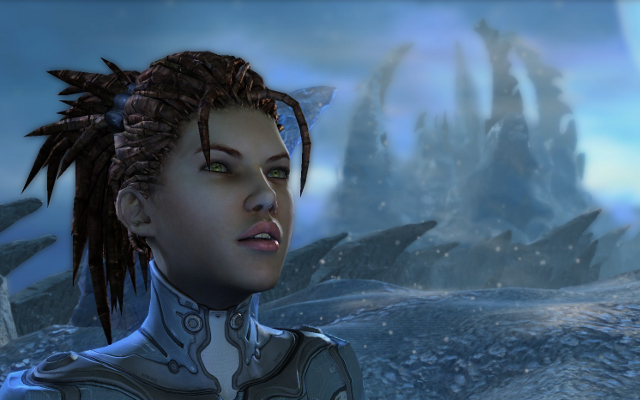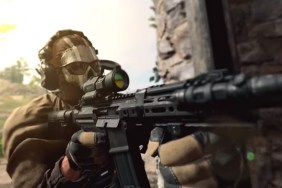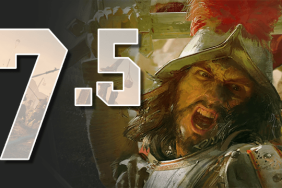She’s the Queen of Blades, not the Queen of Relationships.
Sarah Kerrigan is one of the most iconic heroes in Blizzard’s repertoire, and she’s front and center for StarCraft II’s first expansion, StarCraft II: Heart of the Swarm. But she doesn’t travel alone. Along with her is a swarm of new content looking to pull you back into the world of StarCraft.
StarCraft II has recently hit a rough spell with competing RTS titles, namely League of Legends and Dota 2, making its popularity in eSports and RTS circles unfavorable. Needless to say, Blizzard has gone all-in to try and win people’s hearts the same way it did with StarCraft: Brood War. But is it enough?
The campaign in HOTS takes off right where StarCraft II: Wings of Liberty ended. It immediately addresses the cliffhanger of the original and reminds you that Kerrigan is someone nobody wants to mess with. It does an excellent job of easing you into the intricacies of Zerg play; something which you’ll appreciate as you progress through the story’s 20 missions. Though, that’s not to say that the game is challenging; it’s actually quite the opposite. If you’re looking for any form of challenge, you’re best off starting on Hard. From there you’ll find the strategic side that the series is known for, rather than the mind-numbing nature of the default difficulty.
After the first few missions, the campaign can begin to feel like a grind since the story presentation isn’t articulated well. The voice acting feels forced and misses execution on a regular basis. If that weren’t enough, the dialogue is some of the most ridiculous that Blizzard has ever written.
To help make up for this pronounced blemish in an important title for the story arch, the game infuses several extras to keep you entertained. Kerrigan is treated as an important—and arguably overpowered—hero unit that evolves through the campaign. With progression she gains new abilities and powerful passives for her swarm that are far from trivial. To help boost her level as high as possible, you’re incentivized to complete bonus objectives in each mission. These optional objectives are attractive and even reward you with achievements.
Similarly, several Zerg units can be evolved and mutated through a series of decisions and well-presented Evolution Missions. Combined with Kerrigan’s progression, the new Zerg mutations offer a profound impact on the battlefield that can be the mild distraction the campaign needs to avoid descending into monotony.

Visually speaking, HOTS is largely the same game you played in 2010, albeit with some fantastic new physics. Unit deaths are accentuated with violent explosions followed by ragdoll behavior and new sound effects. By themselves, the physics do a lot to make battles even more intense—nothing beats seeing your opponent explode into smithereens. Unfortunately, the non-CGI cutscenes and environments are dated by today’s standards, though the game is able to retain the StarCraft look and feel that it’s known for. Blizzard has even put in the effort to optimize the game for less powerful machines, so gamers who weren’t able to play the game with stable framerates before are welcome to give it a second try.
Many of the valuable improvements made to StarCraft II’s multiplayer came in the form of the recent 2.0.4 patch which completely redesigned the UI layout and made significant changes to the multiplayer arena. The changes were global so even players without HOTS have been able to enjoy them. Consequently, some of the appeal of the expansion isn’t even part of the package, but it does introduce several elements of its own to warrant its $39.99 price tag.
The most important addition of HOTS to the multiplayer front is its seven new units. The Terran’s Hellbat and Widow Mine add new solutions for dealing with groups of enemies, and the Widow Mine in particular is devastating if micro’d carefully. You might even find yourself destroying the enemy's economy if your opponent isn’t careful. The Protoss’s Mothership Core, Oracle, and Tempest improve the Protoss’s air potency which made Stargates surprisingly rare in Wings of Liberty. The Zerg’s Viper and Swarm Host are more niche than their counterparts and require thoughtful micro to use correctly. But that comes with benefit as both are high-reward units that add more trickery to the Zerg arsenal.
Additionally, the mutations seen in the campaign mode are available in the Galaxy Map Editor. The 2.0.4 patch made the Arcade (player-made map library) much more popular with a proper main menu link and new features which are worth a look. Furthermore, the mutated Zerg units might not be available in ranked games, but are destined to see plenty of use in Arcade given how fun they are to use.

Most of the new maps in this expansion take advantage of the new tile sets introduced in the HOTS campaign, some of which are the best yet. The maps follow the tradition of StarCraft II's level design with natural expansions, gold mineral patches, and symmetry to promote balance, but the addition of collapsible rocks adds a unique element of strategy to online play.
A new level system accompanies HOTS to add a sense of progression. Previous iterations of StarCraft have placed their entire emphasis on Ladder, but now everyone can see tangible development from their hard work by climbing in levels and subsequently unlocking new decals, skins, and dance animations. This, in addition to the robust Ranked Ladder of StarCraft II, has made continued play more enticing for everyone.
StarCraft II: Heart of the Swarm is conclusively a must-have for anyone who wishes to continue being relevant in competitive play. For casual players who merely enjoy building a base and waging war in sci-fi space, it’s a worthy, although non-groundbreaking, expansion. In tandem with the recent 2.0.4 patch StarCraft II is back on the map and ready to combat the MOBA games which have dethroned it. Even if it doesn’t succeed in doing so, at least now it’s in a state where StarCraft fans can feel satisfied. Provided they don’t value campaign too much, anyway.
-
StarCraft II’s multiplayer is now an addicting affair for everyone
-
A campaign with forgettable voice acting and dialogue
-
Leveling Kerrigan and evolving units adds much-needed respite
-
Seven new units that can’t be ignored
-
A few of which you’ll shy away from unless you’re a pro
-
A leveling system with dozens of varied rewards
-
Many of the profound changes aren’t exclusive to Heart of the Swarm
-
New physics add exclamation to battles







